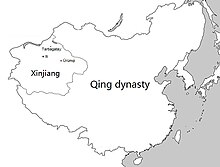Xinjiang (historical area)
Xinjiang (新疆; Uyghur: شىنجاڭ), alternatively romanized as Sinkiang, is an area located in Central Asia, between 73 ° 5 'to 96 ° 4' east and 35 ° 5 'and 49 ° north, in total 1,660,000 square km, sharing borders with Mongolia, Russia, Kazakhstan, Kyrgyzstan, Tajikistan, Afghanistan, India, Pakistan and China's Tibet Autonomous Region, Qinghai Province and Gansu Province.
This area revolted against the Qing empire in the middle of the 19th century[3] and the rebels against the regime were subsequently reunified by Yaqub Beg of West Turkestan.
For the indigenous peoples of this region (mainly Turkic peoples), the word 'Xinjiang' is a foreign language word with colonialist implications and no connection to the local historical and cultural traditions.
They use the name East Turkestan (Uyghur: شەرقىي تۈركىستان, Sherqiy Türkistan; Chinese: 东突厥斯坦, Pinyin: Dōng Tūjuésītǎn) to refer to this area.
[6] Due to the existence of the East Turkestan independence movement, apart from the original cultural and geographical meaning, this name has political overtones.



